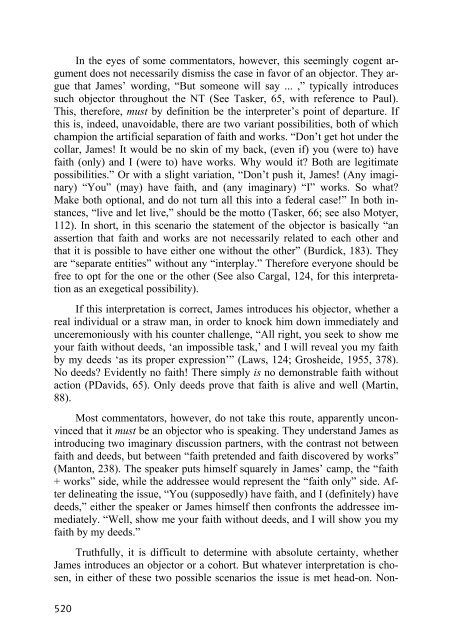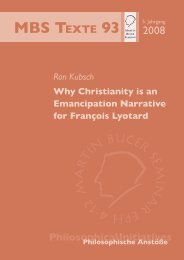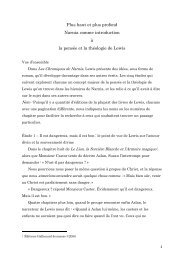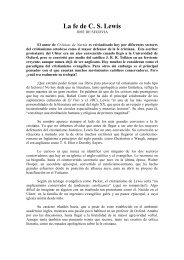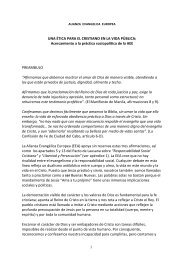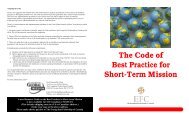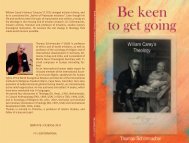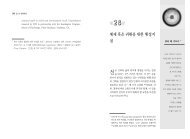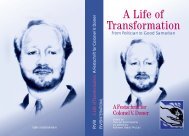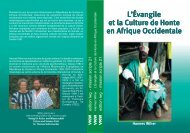- Page 1 and 2:
All too often James was either negl
- Page 3 and 4:
Theologisches Lehr- und Studienmate
- Page 5 and 6:
Die Deutsche Bibliothek - CIP Bibli
- Page 7 and 8:
(Deut. 30:14-20; 32:46-47; Rom. 7:1
- Page 9 and 10: cation with God, his Word and his c
- Page 11 and 12: the indispensable precursor of the
- Page 13 and 14: James’ injunction gains in force
- Page 15 and 16: 11:25). James’ illustration is on
- Page 17 and 18: On the other hand, the “beggar”
- Page 19 and 20: 15:8 and Jude 22, where the verb is
- Page 21 and 22: partly ad hominem, and twofold. It
- Page 23 and 24: fact, it is a known fact that God i
- Page 25 and 26: ality, so graphically described by
- Page 27 and 28: community. These members obviously
- Page 29 and 30: Decalogue, and the standard of the
- Page 31 and 32: love is merely a first shot before
- Page 33 and 34: At the same time it is equally regr
- Page 35 and 36: (Rom. 13:8; Gal. 5:14) (Mitton, 91)
- Page 37 and 38: wholesome and displays healing powe
- Page 39 and 40: Ultimately, of course, “the organ
- Page 41 and 42: All in all, James urges his readers
- Page 43 and 44: other gross transgressions of God
- Page 45 and 46: God’s patience is his goodness in
- Page 47 and 48: 506 III. Stipulations: Prescribed C
- Page 49 and 50: “scaffolding” (political regula
- Page 51 and 52: Returning now to James, the present
- Page 53 and 54: (Motyer, 106) through his readers b
- Page 55 and 56: James. Similarly, it is questionabl
- Page 57 and 58: this sin is defiling the temple of
- Page 59: heaven (Eph. 2:6; Col. 3:3; Heb. 10
- Page 63 and 64: “involves the whole inner man, an
- Page 65 and 66: equally ringing “Yes!” also wit
- Page 67 and 68: practical, even if not an explicit
- Page 69 and 70: this Topical Focus is to lay out th
- Page 71 and 72: out of the people of God, because t
- Page 73 and 74: Second, without (necessarily) dismi
- Page 75 and 76: we relate these two seemingly contr
- Page 77 and 78: to, and is matched by, meticulous a
- Page 79 and 80: in on the latter. As one commentato
- Page 81 and 82: not, and all protestations to the c
- Page 83 and 84: James editorializes about Genesis 2
- Page 85 and 86: works. He was declared righteous fo
- Page 87 and 88: edly) confirmed and certified soldi
- Page 89 and 90: ecause of the moral character and c
- Page 91 and 92: works necessary in foundational jus
- Page 93 and 94: speak about imputed righteousness,
- Page 95 and 96: 2. The first half, to the effect th
- Page 97 and 98: 556 Now if you doubt that I am Chri
- Page 99 and 100: “To fulfill,” therefore, equals
- Page 101 and 102: shaking) evidence of its authentici
- Page 103 and 104: But there is a second element. Abra
- Page 105 and 106: concept of truth (‘emeth). The fo
- Page 107 and 108: soul should be united to constitute
- Page 109 and 110: 568 God because of his own inabilit
- Page 111 and 112:
the very moment of its birth. Even
- Page 113 and 114:
into a burning issue. “You must b
- Page 115 and 116:
574 1. OBSTACLE TO VICTORY (3:1-9)
- Page 117 and 118:
Second, he indicates that both the
- Page 119 and 120:
James 3:10-18 aims at this very sam
- Page 121 and 122:
ity go hand in hand. Therefore, if
- Page 123 and 124:
limit (Rom. 12:6). The presence of
- Page 125 and 126:
to dissuade those who are inadequat
- Page 127 and 128:
penalties” (Dibelius, 182). The c
- Page 129 and 130:
Christ by grace through faith, and
- Page 131 and 132:
the present context this is not iro
- Page 133 and 134:
depth. He clearly has an additional
- Page 135 and 136:
Of course, he does not stop there.
- Page 137 and 138:
All this should under no circumstan
- Page 139 and 140:
Mark well that this is not stated a
- Page 141 and 142:
that is “death bearing” and “
- Page 143 and 144:
is meant is any “slighting” of
- Page 145 and 146:
(even partially) lost. This must le
- Page 147 and 148:
former must be conformed to the lat
- Page 149 and 150:
608 2. NATURE OF VICTORY (3:10-18)
- Page 151 and 152:
(first statement) no fresh fountain
- Page 153 and 154:
application of this principle. (1)
- Page 155 and 156:
and progressions only serve to high
- Page 157 and 158:
4:12; Heb. 13:7; 1 Pet. 1:15,18; 2:
- Page 159 and 160:
At any rate, he had no ax to grind,
- Page 161 and 162:
from the teaching of both the OT an
- Page 163 and 164:
It is sobering to realize that Jame
- Page 165 and 166:
quer and occupy “territory” of
- Page 167 and 168:
626 (2) Explanation of Defeat (3:15
- Page 169 and 170:
of the basic building blocks, the A
- Page 171 and 172:
(Nystrom, 217) that is rock-like, b
- Page 173 and 174:
country, marked by rebellion and tu
- Page 175 and 176:
2:20; Eph. 1:3; Ph. 4:13). It is ap
- Page 177 and 178:
not. It is interesting to note that
- Page 179 and 180:
Christian (John 14:27; 16:33) and i
- Page 181 and 182:
way in terms of his aspirations and
- Page 183 and 184:
mindedness of James 1:6 and the fav
- Page 185 and 186:
This harvest consists not only of t
- Page 187 and 188:
pensable prerequisite in order for
- Page 189 and 190:
648 3. REQUIREMENTS FOR VICTORY (4:
- Page 191 and 192:
“lust,” “passionately yearn
- Page 193 and 194:
ally is a vox media and stands for
- Page 195 and 196:
authority structures (See Topical F
- Page 197 and 198:
656 (2) Reason for One’s Conditio
- Page 199 and 200:
promoted out of the way. Events are
- Page 201 and 202:
heart-rending, praying. “Seek and
- Page 203 and 204:
want it?) or about the object (Is i
- Page 205 and 206:
8:38) (Moo, 1985, 143). Because Chr
- Page 207 and 208:
idea), or presents it as the capsto
- Page 209 and 210:
a complete repudiation of the ‘wo
- Page 211 and 212:
the cross of our Lord Jesus Christ,
- Page 213 and 214:
worship and obedience (Ropes, 263;
- Page 215 and 216:
that God gives more than sufficient
- Page 217 and 218:
ence upon the grace of God in the a
- Page 219 and 220:
dividual and personal (Zodhiates, I
- Page 221 and 222:
against God’s church (2 Thess. 2:
- Page 223 and 224:
and fasted and prayed day and night
- Page 225 and 226:
The “purity” theme carries over
- Page 227 and 228:
ognize this, acknowledge it, and th
- Page 229 and 230:
quite clear that James aims in all
- Page 231 and 232:
identify themselves as a Pharisee,
- Page 233 and 234:
Saints, are certainly owned by the
- Page 235 and 236:
IV. THE RANGE OF HOLINESS IN THE FA
- Page 237 and 238:
(Jam. 1:19ff) and substantiated in
- Page 239 and 240:
literally states that Christians ma
- Page 241 and 242:
Cor. 13:6). This misuse of the tong
- Page 243 and 244:
of the Church, and the recovery of
- Page 245 and 246:
centuries. Without them, however wo
- Page 247 and 248:
706 for a little while and then van
- Page 249 and 250:
procedure cannot be faulted or cond
- Page 251 and 252:
1:13). It even requires us to calcu
- Page 253 and 254:
lineate how we can expect anyone to
- Page 255 and 256:
of God (Portland: Multnomah Press,
- Page 257 and 258:
716 (3) It Paralyzes Third, the con
- Page 259 and 260:
718 (2) Delight in God’s Law But
- Page 261 and 262:
720 4. Conclusion To close with two
- Page 263 and 264:
To summarize, if I wish to engage i
- Page 265 and 266:
724 (3) Nature of Presumption (4:16
- Page 267 and 268:
eminder” that “the sins of omis
- Page 269 and 270:
728 2. FACING “YOURSELF” (5:1-1
- Page 271 and 272:
that follows in the fourth and fina
- Page 273 and 274:
In James 2:15-16 he implicitly rebu
- Page 275 and 276:
fore, to assign the “rich” in t
- Page 277 and 278:
In the present situation, James ass
- Page 279 and 280:
lievers, filled with the Spirit, su
- Page 281 and 282:
At any rate, according to James, in
- Page 283 and 284:
pick up and enlarge on Calvin’s r
- Page 285 and 286:
ter, are there to share with others
- Page 287 and 288:
sense she foreshadowed himself. Aft
- Page 289 and 290:
ivers of water. In fact, it only ne
- Page 291 and 292:
At any rate, in the light of the se
- Page 293 and 294:
The OT universal principle, applied
- Page 295 and 296:
of Christ, whether in campus evange
- Page 297 and 298:
should have toward the funding of h
- Page 299 and 300:
to show for. This came into view wh
- Page 301 and 302:
Capital campaigns set a specific fu
- Page 303 and 304:
for him, so that he is delivered fr
- Page 305 and 306:
To be more precise, proper Kingdom
- Page 307 and 308:
766 3. Gospel Vision The Church wil
- Page 309 and 310:
were to decree this! In fact, the u
- Page 311 and 312:
ering of all for readers of James t
- Page 313 and 314:
ing. What does not originate in him
- Page 315 and 316:
No, the present section should be f
- Page 317 and 318:
Note the connector “So then” at
- Page 319 and 320:
equal all-consuming force in the li
- Page 321 and 322:
Fourth, the “preciousness of the
- Page 323 and 324:
eplaced. But at the same time, the
- Page 325 and 326:
covenant community makes a spectacl
- Page 327 and 328:
From this perspective Matthew 6:14-
- Page 329 and 330:
“models” to emulate (John 13:15
- Page 331 and 332:
It has been argued that neither the
- Page 333 and 334:
model for endurance is a faux-pas.
- Page 335 and 336:
mighty hands of his Father! Suddenl
- Page 337 and 338:
scene is dark and forbidding. Patie
- Page 339 and 340:
weapon to strike back at the rich,
- Page 341 and 342:
shoulders, or an “oh, well.” Th
- Page 343 and 344:
a noble effort based upon an approa
- Page 345 and 346:
plains the function of James 5:12.
- Page 347 and 348:
upperlip and frivolous giddiness.
- Page 349 and 350:
ackdrop it is difficult to miss the
- Page 351 and 352:
something bad is happening to "me"
- Page 353 and 354:
812 (3) Model of God-centeredness (
- Page 355 and 356:
Acts 3:6, 16). James clearly indica
- Page 357 and 358:
name of the Lord! This may well be
- Page 359 and 360:
content of prayer, there may be tot
- Page 361 and 362:
First, James’ focus here is the f
- Page 363 and 364:
minal sicknesses, that require a sh
- Page 365 and 366:
clearly expressed by Jesus (Mt. 15:
- Page 367 and 368:
participation! What comes into view
- Page 369 and 370:
Greek suggests that what James has
- Page 371 and 372:
community, such injunction is recog
- Page 373 and 374:
212; Nystrom, 308; see also Stulac,
- Page 375 and 376:
Scripture supports this thesis as w
- Page 377 and 378:
falls short of it stands rebuked. L
- Page 379 and 380:
the Christian knows that the absenc
- Page 381 and 382:
840 1. INSTRUMENTS OF CONVERSION (5
- Page 383 and 384:
842 b. Returning to the Truth (5:19
- Page 385 and 386:
Of course, both the conversion of t
- Page 387 and 388:
846 2. RECIPIENTS OF PARDON (5:20b-
- Page 389 and 390:
acknowledgment of the significance
- Page 391 and 392:
One commentator who adopts this exp
- Page 393 and 394:
think twice before surrendering to
- Page 395 and 396:
If and when the Church goes down to


